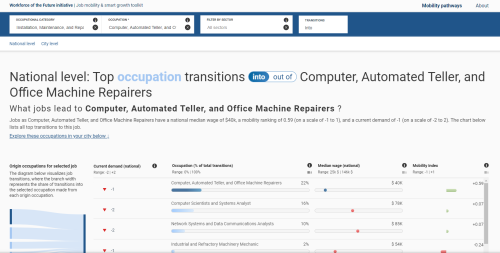Workers, firms, and policymakers each have a role in bolstering economic mobility. Our Mobility Pathways tool can help all of these groups harness relevant data to expand opportunities for mobility and growth.
Users can compare jobs by wage level, current demand (estimated from real-time job postings), and “mobility index” ranking (a new indicator we constructed that ranks occupations based on whether their workers typically transition into higher-paying jobs).
The Mobility Pathways tool is designed with a few key “use cases” in mind:
1. Workers (and organizations supporting them) who want to explore realistic pathways to higher-paying jobs.
Navigating today’s labor market is overwhelming and high-stakes—the tool highlights realistic upward pathways from any given job. If you’re a retail salesperson, it shows the most common jobs that people in retail typically transition to, and how those potential transitions compare to your current job. You’ll learn that retail workers most commonly transition to retail supervisors or cashiers, but the most promising potential transitions are to jobs as stock clerks or material movers—which each have higher median wages, higher mobility rankings, and are in higher demand than retail sales jobs.
2. Businesses that want to fill staffing needs while supporting upward mobility.
Our tool can help human resource managers explore “source” occupations for any job vacancy—including less intuitive linkages from lower-wage occupations that are still likely to succeed in the role, perhaps with targeted training or upskilling. If you’re a growing tech company looking for computer analysts, the tool shows which occupations have historically transitioned into computer analyst jobs and the current demand for those source occupations. You’ll learn that office machine repairers, with some upskilling, might be a great fit—while offering your organization the chance to provide real career mobility to workers in a lower-wage, lower-demand occupation.
3. Policymakers who want real-time, actionable data on their labor market.
State and city governments need a solid understanding of local employment to facilitate economic growth and upward mobility. During the current recession, with demand surging for a narrow set of occupations as many industries struggle, the tool can help policymakers facilitate strategic employee sharing—in which workers at slumping companies are temporarily matched with firms experiencing spikes in demand. Looking to the future, the tool can help tailor economic development plans, build talent pipelines to attract and retain firms, and better target upskilling, reskilling, and workforce development programs.
For example, the city of Boise, Idaho committed to transition to 100 percent renewable energy by 2035. To do that, they will likely need wind turbine technicians—an occupation expected to grow significantly that pays decent wages and does not typically require workers with bachelor’s degrees, making it an attainable, middle-wage occupation. Our data show that a range of low- and mid-wage jobs, including building cleaners, construction workers, truck drivers, assemblers, and stock movers can feasibly move into higher-paying wind turbine jobs.
Armed with this information, Boise leaders could help nurture the city’s transition to renewable energy while also promoting upward mobility. They could liaise with companies, educational institutions, and workforce development organizations to build capabilities and talent in these and other source occupations, facilitating realistic upward transitions for lower-wage workers and creating a conducive environment for firm staffing needs. In the meantime, they would be building off-ramps for at least two declining occupations: Nationally, many truck driver and stock moving jobs are prone to long-term automation, while wind turbine technician jobs are predicted to grow and offer significantly higher pay.
The Mobility Pathways tool is just the first element of our planned multipart job mobility and smart growth toolkit. In the weeks and months to come, we will be rolling out tools to help local leaders grow industries that improve their regions’ job quality as well as tools to encourage companies to retrain workers and promote internal pathways rather than fire and hire. The tools aim to accommodate the purposes of workforce organizations, companies, or policymakers. More importantly, the dashboard can serve as a touchstone for local leaders to align efforts to improve outcomes in their community.
The Job Mobility Toolkit is a product of the Workforce of the Future initiative at Brookings.








Commentary
Introducing the Mobility Pathways tool for workers, employers, and policymakers
November 10, 2020